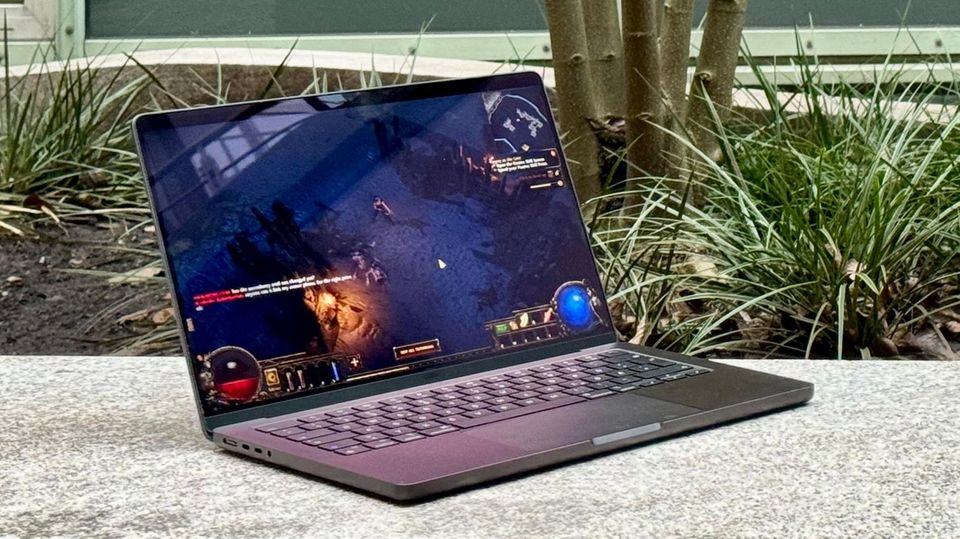With the new Macbook Pro, Apple has once again raised the bar for notebooks. One component that was particularly impressive in the test was one that was also made in Germany.
It is a chic but rather inconspicuous building in which Apple is working on his future. The group moved into its new research center in the Marsfeld in Munich last year. You won’t find the famous apple logo on the building, but you’ll still find Apple magic behind the doors. And not just in the office furnishings that are reminiscent of Apple’s stores. In Munich, almost 3,000 engineers from all over the world develop the chips with which the company has long been leaving its competitors behind. And the M3 Max, which powers the new Macbook Pro, proves to be the current masterpiece of these efforts in the test.
A dream in black
Even if the new Space Black color is a real eye-catcher, the real star of the notebook in the test is clearly its chip. That doesn’t mean that the notebook doesn’t look good. The design with its clear shapes and rounded edges still looks very fresh even after three years. But nothing has changed much compared to the previous models. Whether ports, display or keyboard: the new MacBook At first glance, Pro cannot be distinguished from its older siblings.
The only – but even bigger – exception is the new color. For the first time since 2008, Apple is offering Space Black on its Notebooks again a black color variant. It’s not as dark as the piano black of the time. However, the aluminum housing is significantly darker than the previous space gray. The fact that Apple is offering the new color may also have something to do with a material innovation: the company’s engineers have managed to design the housing in such a way that it does not collect fingerprints despite the dark color. At least not permanently. Because of course the styli do leave an imprint in the test. But if you wipe it with your hand once, it disappears again. This means that the Macbook Pro almost always looks elegant.

The Macbook Pro always looks elegant – occasional fingerprints can be easily wiped off.
© Malte Mansholt / stern
Performance full
But the real innovations are inside. Those also in the laboratories Munich The M3 chips developed are the second generation of processors in a year. Apple only introduced the M2 Pro and M2 Max in January, and now the successors are already going on sale. And they bring with them a huge innovation: the M3 processors are the first computers on the market to be manufactured using the 3-nanometer process – and thus not only offer more performance with less power consumption, but also several completely new functions.
This pays off especially in the black high-end models. With the M3 Pro and M3 Max, Apple only uses the cream of its current processor line. The M3 Max installed in the test sample really has it all. With up to 16 computing and 40 graphics cores, it offers a lot of performance on paper. And then it manages to exceed the high expectations in practice. Whether video editing, photo editing, 3D-Models or games: The new chip can hardly be made to sweat in practice. From everyday tasks to computationally intensive architectural files, the M3 Max works stoically and without complaint.
The Mac whispers quietly
And literally. Because in most application scenarios you won’t even notice that the computer has a fan installed. Only when he was tasked with graphics-intensive work in the test did he suddenly hear a noise that was briefly irritating: at 100 percent graphics load, the fan audibly switched on out of nowhere. But this was only noticeable because previously not even a whisper could be heard from the housing.

Space black is not deep black: depending on the light, the new color looks more like a classy dark gray.
© Malte Mansholt / stern
Apple has placed a lot of emphasis on graphics performance. With its up to 40 graphics cores, the M3 Max is very suitable for gaming and creates extremely smooth displays in games like “Path of Exile” even on full graphics settings – while still having reserves. For most buyers, however, this is more of a bonus: Hardly anyone buys a Mac as a gaming device. But at least you can now use it for that too.
Waiting for the third party
It’s a shame: the full graphics potential of the chips could not yet be accessed in the test. The M3 chips support ray tracing, i.e. the calculation of every single ray of light in 3D environments. This makes games and other three-dimensional content look even better. This used to only be possible with dedicated graphics cards. However, new buyers have to be patient: no games available for the Mac support the technology yet. However, some titles such as the classic “Myst” have already announced corresponding updates. In demo programs developed by Apple, the effect already looks great.
A second exciting technology of the M3 chips will only prove its full potential over time. The so-called “Dynamic Caching” allows the Mac to adjust the RAM requirements of programs in real time – and thus use the memory more efficiently. If the programs are adapted accordingly, you can use significantly more different apps at the same time without having to use more RAM.
This is especially good because Apple forces customers to make a decision when purchasing the M3: The RAM cannot be expanded later. Although the basic configuration of at least 36 GB is quite generous, if you need more, you’ll have to pay a lot more. It is to be hoped that dynamic caching will reduce demand pressure somewhat.
Full power on the go
The new top performance can also be noticed in the battery – in two very different ways. If the notebook is actually firing on all cylinders, you can practically watch the charge level drop. The battery can then go down by up to two percent per minute. However, this extreme load is likely to be the absolute exception. In order to fully utilize all 16 cores, you have to put a lot of work on the notebook; even processing several 4K films at the same time is not enough.
The fact that this extreme load is even possible while on the move is remarkable in itself: unlike its competitors, the M3 Max does not throttle down when it goes into battery mode – but continues to offer full performance. Anyone who really needs this will appreciate it. It’s just better not to take too long. At 100 percent utilization, the battery was drained after just a good hour under full load.

Video games on the go are no problem at all – but the device requires a lot of power, so you should keep an eye on the battery.
© Malte Mansholt / stern
But that doesn’t mean that the device can’t last significantly longer. If you don’t constantly use high performance, you’ll have the opposite experience: With the M3 Max, not only did the eight performance cores get more steam, but also the eight energy-saving counterparts. In everyday life this means: You can expect more performance from the Macbook Pro without having to use the high-performers. And this ensures that the battery also lasts longer. Apple promises a runtime of up to 22 hours, compared to just 18 hours with the predecessor. This seems very realistic after almost two weeks of mixed use. Even if you regularly need more power, you should be able to get by without a cable for a normal working day without any problems; for everyone else, you can even get a second day.
Known well
In every other respect, the new Macbook Pro are familiar – and as good as usual. The displays are still bright, sharp and colorfast. The resolution is still 3024 by 1964 pixels, the dynamic refresh rate called Promotion allows up to 120 images per second. The peak brightness of 1600 nits ensures that the display is easy to read even outside.
The ports also remain the same: The models with M3 Pro and M3 Max each offer a Magsafe port for charging, an HDMI socket and three Thunderbolt ports according to the USB-C standard. There is also a slot for SDXC cards.
High prices
An Achilles heel of the new Macs is what at first glance appears to be an enormously high price. The model with M3 Pro Max in 14 inches costs at least 3999 euros. If you want a larger display or more RAM, graphics performance or data storage, the price keeps climbing. And in steps that are noticeably higher than the market prices for the components. After all, the basic equipment of at least 36 GB of RAM and 1 TB of data storage is more than sufficient for most users.
To be fair, it must also be said that these prices are unlikely to deter the target group. With the Macbook Pro, Apple is clearly – as the addition suggests – aimed at professional customers. And anyone who can really recoup the extra performance in money or thereby significantly save working time will be happy to pay the sums requested. Especially since this package of performance and portability is not available anywhere else on the market: no other computer can access such performance without a cable – and then last for as long.
Conclusion: A new reference
With the Macbook Pro with M3 Max, Apple has managed to outdo itself once again within a year. The last model was already completely convincing (read the test here), but with the jump to 3 nm technology, the M3 can top that. More performance with a longer runtime would be convincing, but with modern new features such as ray tracing and dynamic caching, Apple offers significant added value. It’s also acceptable that apart from the new color option, everything else has largely been left the same. The Macbook Pro with M3 Max is a new reference on the notebook market.
The biggest drawback, however, remains: With a price starting at 3,999 euros, the basic model of the Macbook Pro with M3 Max is anything but suitable for the masses, and Apple also pays well for the optional upgrades. However, anyone who needs the performance will accept this. For everyone else, the cheaper M3 models or one of the predecessor devices are the better choice.




